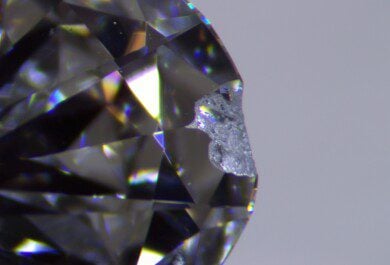In a previous article, I briefly touched the aspect of perception in our judgement of numbers. I made the case, that since most diamond professionals first gather their knowledge with round brilliants, that they automatically apply rules for rounds to fancy shapes. This is also true with numbers.
In this article, I will give you some examples how numbers and perception can interact.
Example 1. An AGS-0 princess-cut, Crafted by Infinity
Here are the basic measurements for this stone, as mentioned on the AGS-report:
| Weight: |
1.257 Cts. |
| Measurements: |
5.78 x 5.78 x 4.60 mm. |
| Total depth: |
79.6% |
| Table %: |
59.7% |
| Crown angle: |
32.8° |
| Crown height: |
11.2% |
| Pavilion angle: |
42.7° |
| Pavilion depth: |
64.9% |
| Girdle |
2.7% to 3.8% |
| Culet: |
Pointed |
Example 2. The same diamond, but with the measurement noted in the same way as for a round brilliant
In a round brilliant, all percentages are calculated as a percentage of the average diameter, while in fancy shapes, they are calculated as a percentage of the smallest diameter. Let us now show you the measurement of the same diamond, but this time according to the normal notation of a round brilliant.
| Weight: |
1.257 Cts. |
| Measurements: |
8.17 x 5.78 x 4.60 mm. |
| Total depth: |
65.9% |
| Table %: |
49.4% |
| Crown angle: |
32.8° |
| Crown height: |
9.3% |
| Pavilion angle: |
42.7° |
| Pavilion depth: |
53.8% |
| Girdle |
2.2% to 3.1% |
| Culet: |
Pointed |
Just looking at the figures, these measurements look a lot better than in the first example. First, it clearly shows the diameter from point-to-point being 8.17 mm. Also, the total depth-notation went from 79.6% to 65.9%, which sounds a lot better, especially since we are used to depths around 60% in round brilliants.
Examples 3 & 4
Example 3. The same diamond, but depth measured in relation to the longest diameter
Let us take the example a bit further even. Here are the measurements, if we take the depth and table in relation to the longest diameter of 8.17mm.:
| Weight: |
1.257 Cts. |
| Measurements: |
8.17 x 5.78 x 4.60 mm. |
| Total depth: |
56.3% |
| Table %: |
42.2% |
| Crown angle: |
32.8° |
| Crown height: |
7.9%< |
| Pavilion angle: |
42.7° |
| Pavilion depth: |
45.9% |
| Girdle |
1.3% to 1.8% |
| Culet: |
Pointed |
Wow. Did you see that total depth? Only 56.3%, that must be a whopping spready stone.
OK. I admit, I am truly exaggerating with mathematical wizardry in this example. After all, statistics can prove anything. I just wanted to show that the way measurements are noted, can give a totally different feeling about the diamond. In this sense, the difference between example 1 and 2 are important, since we are just using the notation-rules of rounds in example 2. Knowing that most of our knowledge in diamonds started in round diamonds, and that we are extremely used to measurements of rounds, example 2 is an example in which we are truly comparing apples to apples.
Example 3 is exaggerated, I admit, but take a look at this example.
Example 4. Measurement of a Dream Diamond by Hearts-on-Fire
The Dream Diamond is a trademarked proprietary square cut diamond, marketed by Hearts-on-Fire. We have taken the following example from the Hearts-on-Fire-website (www.heartsonfire.com) with stocknumber DRM6048.
| Weight: |
1.258 Cts. |
| Measurements: |
7.12 x 5.94 x 4.41 mm. |
| Total depth: |
61.9% |
| Table %: |
55.0% |
| Pavilion angle: |
40.9° |
| Girdle |
1.2% to 1.4% |
| Culet: |
Pointed |
This diamond is a very symmetrical square stone, and the diameter from side-to-side is 5.94mm. Because of the cut corners, the diameter from point-to-point is 7.12mm. The total depth is noted in relation to the highest diameter (4.41 divided by 7.12 is 61.9%). It is logical to assume that the table and girdle percentages are also in relation to that highest diameter.
With the Dream Diamond being a proprietary cut, the company itself can choose how the measurements are presented. It is interesting to see how Hearts-on-Fire has chosen to represent its stone as in our example 3.
The result of this choice is obvious. The total depth-percentage and the table-size look very similar to what we are used to in round brilliants. At the same time, crown height is not mentioned, because (as we can see in example 3), this would look very low compared to what we are used to in rounds.
Conclusion
In the previous examples, you can see that the way a diamond’s measurements are reported is subject to certain choices or rules. Any professional should be aware of these choices, since they have an effect on how these measurements will look.
Since almost all of us have been trained in round brilliants, we have a tendency to immediately compare certain measurements to what we are used to in rounds. This article shows that this could lead to incorrect interpretations.











